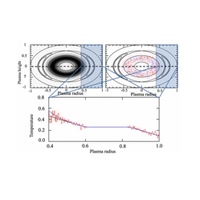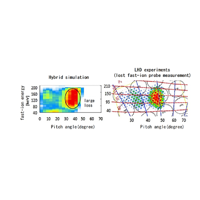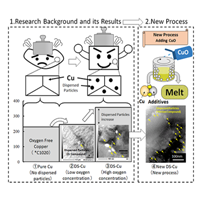Research Report2019

Development of an experimental database of emission spectra from various elements using LHD
Various elements with atomic numbers from 36 to 83 have been injected into LHD plasmas to observe their emission spectra. Spectra for various atomic numbers and electron temperatures have been systematically investigated by comparisons with theoretical calculations. ...

Better confinement characteristics in deuterium plasma than in hydrogen plasma
For the prediction of future reactor performance with deuterium and tritium plasma, confinement characteristics are compared in hydrogen and deuterium plasmas. ...

Explore the behavior of hydrogen isotopes using a tracer
Hydrogen isotopes' behavior in a fusion test device has been clarified by use of a small amount of tritium, that was produced in deuterium plasma using the Large Helical Devices (LHD) as a tracer. ...

Turbulence permeating the inner part of a plasma magnetic island
The "instantaneous heat propagation method" devised for the Large Helical Device (LHD) at the National Institute for Fusion Science was applied to a tokamak device (Doublet III-D) in the United States. ...

Simulations demonstrate ion heating by plasma oscillations for fusion energy
A research team of fusion scientists succeeded in proving that ions can be heated by plasma oscillations driven by high-energy particles. ...

Demonstration of alpha particle confinement capability in helical fusion plasmas
A team of fusion researchers succeeded in proving that energetic ions with energy in mega electron volt (MeV) range are superiorly confined in a plasma for the first time in helical systems. ...

Fusion scientists have developed 'the nano-scale sculpture technique'
A research team of fusion scientists has succeeded in developing "the nano-scale sculpture technique" to fabricate an ultra-thin film by sharpening a tungsten sample with a focused ion beam. ...

Making it possible to analyze light coming from the universe for approaching the origin of heavy ions: Computing atomic data of the highest precision
Various kinds of elements exist around us. Almost all of the elements were created in the universe.※ It is believed that the universe was born by the Big Bang of the phenomena such as the big explosion. Then, light elements such as hydrogen and helium and so on were made. ...

Predicting behaviors of fast ions:Comparative research of hybrid simulation with experiments
To achieve fusion power, it is necessary to heat plasma to a high temperature of more than one hundred million degrees so that the fusion reaction continues. ...

Fusion Science and Astronomy Collaboration Enables Investigation of the Origin of Heavy Elements
A research team of experts in atomic physics, nuclear fusion science, and astronomy succeeded in computing millions of highly accurate atomic data of neodymium ions in the Japan-Lithuania international collaboration. This research accelerates studies of a long-standing mystery regarding the origin of precious metals such as gold and platinum in our universe. ...

Generating powerful electromagnetic waves heating plasma electrons:Design developing research of gyrotron
To achieve nuclear fusion power, it is necessary to heat plasma to the extreme high temperature of more than one hundred million degrees. One of the means for heating plasma is a method in which strong electromagnetic waves are launched into plasma. ...

Metal receiving heat from the sun of the ground :Developing the Dispersion Strengthening Copper carrying cooling function
Stars of the Universe, such as the sun, shine due to the fusion reaction. Fusion power makes the fusion reaction on the earth and generates electricity by taking out energy from the fusion reaction. To achieve this, the development of instruments that receive energy generated in the fusion reactor is one of the important issues. ...
